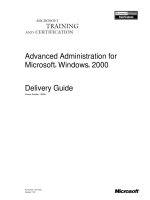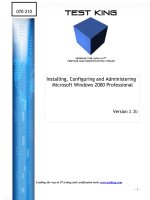Tài liệu Building Distributed Applications for Microsoft® Windows® 2000 with Visual Basic® Delivery Guide pptx
Bạn đang xem bản rút gọn của tài liệu. Xem và tải ngay bản đầy đủ của tài liệu tại đây (202.28 KB, 14 trang )
Course Number: 1907A
Delivery Guide
Building Distributed Applications
for Microsoft
®
Windows
®
2000
with Visual Basic
®
Part Number: X05-42128
Released: 05/2000
Information in this document is subject to change without notice. The names of companies,
products, people, characters, and/or data mentioned herein are fictitious and are in no way intended
to represent any real individual, company, product, or event, unless otherwise noted. Complying
with all applicable copyright laws is the responsibility of the user. No part of this document may
be reproduced or transmitted in any form or by any means, electronic or mechanical, for any
purpose, without the express written permission of Microsoft Corporation. If, however, your only
means of access is electronic, permission to print one copy is hereby granted.
Microsoft may have patents, patent applications, trademarks, copyrights, or other intellectual
property rights covering subject matter in this document. Except as expressly provided in any
written license agreement from Microsoft, the furnishing of this document does not give you any
license to these patents, trademarks, copyrights, or other intellectual property.
2000 Microsoft Corporation. All rights reserved.
Microsoft, BackOffice, MS-DOS, Windows, Windows NT, Windows 2000 Server, Microsoft
Visual Basic, Active Directory, ActiveX, PowerPoint, Visual Basic, Visual Studio, and Windows
Media are either registered trademarks or trademarks of Microsoft Corporation in the U.S.A.
and/or other countries.
The names of companies, products, people, characters, and/or data mentioned herein are fictitious
and are in no way intended to represent any real individual, company, product, or event, unless
otherwise noted.
Other product and company names mentioned herein may be the trademarks of their respective
owners.
Program Manager: Pete Harris
Content Lead: Kathy Narvaez
Instructional Design Contributors: Graeme Malcolm (Content Master Ltd.), Andy Longshaw
(Content Master Ltd.), Alex Mackman (Content Master Ltd.),
Instructional SDE: Kamran Iqbal
Technical Reviewer: Rod Wittmier (WNT, Inc.)
Media Production: Scott Serna (Creative Assets)
Media Management: David Mahlmann
Editing Manager: Jennifer Linn
Editor: Todd Duft (The Write Stuff)
,
Reid Bannecker (S&T OnSite),
Susan Filkins (S&T Onsite)
Production Manager: Miracle Davis
Production Coordinator: Linda Lu Cannon (The Write Stuff)
Build Manager: Julie Challenger
Build Coordinator: Jenny Boe
Test Lead: Eric Meyers
Test Team: Brian Urakawa, Ross Mortimer
Manufacturing Manager: John Williams
Group Product Manager: Steve Elston
Course Number: 1907A
Part Number: X05-42128
Building Distributed Applications for Microsoft® Windows® 2000 with Visual Basic® iii
Contents
Introduction
Course Materials ......................................................................................................2
Prerequisites.............................................................................................................3
Course Outline .........................................................................................................4
Microsoft Certified Professional Program ...............................................................6
Facilities...................................................................................................................8
Module 1: Developing Enterprise Solutions for Windows 2000
Overview..................................................................................................................1
Introduction to Enterprise Development..................................................................2
Introduction to the Windows 2000 Platform..........................................................11
Tools and Technologies .........................................................................................21
Overview of Lab Solution......................................................................................30
Lab 1: Reviewing the Lab Solution .......................................................................35
Best Practices.........................................................................................................39
Review ...................................................................................................................41
Module 2: Designing and Modeling
Overview..................................................................................................................1
Introduction to Analysis and Design........................................................................2
Creating a Conceptual Design..................................................................................8
Lab 2.1: Reviewing the Requirements Document .................................................17
Creating a Logical Design .....................................................................................19
Creating a Physical Design ....................................................................................38
Lab 2.2: Using the Visual Modeler........................................................................50
Best Practices.........................................................................................................55
Review ...................................................................................................................57
Module 3: Introduction to COM+
Overview..................................................................................................................1
From COM to COM+ ..............................................................................................2
COM+ Architecture ...............................................................................................16
Administering COM+ Applications.......................................................................23
Lab 3.1 Building a COM+ Application .................................................................40
Debugging a COM+ Component ...........................................................................48
Deploying a COM+ Application............................................................................57
Lab 3.2: Debugging COM+ Components ..............................................................72
iv Building Distributed Applications for Microsoft® Windows® 2000 with Visual Basic®
Best Practices........................................................................................................ 75
Review .................................................................................................................. 77
Module 4: Managing Transactions and State
Overview................................................................................................................. 1
COM+ Context........................................................................................................ 2
The IObjectContext Interface.................................................................................. 6
Lab 4.1 Using Context Object Services ................................................................ 15
Just In Time Activation......................................................................................... 18
Managing Transactions......................................................................................... 25
Programming COM+ Transactions....................................................................... 38
Lab 4.2 Managing Transactions............................................................................ 48
Managing State ..................................................................................................... 51
Using the Shared Property Manager ..................................................................... 59
Lab 4.3 Storing State in the Middle Tier............................................................... 69
Best Practices........................................................................................................ 74
Review .................................................................................................................. 76
Module 5: Queued Components and Events
Overview................................................................................................................. 1
Introduction to Queued Components ...................................................................... 2
Working with Queued Components...................................................................... 16
Lab 5.1 Creating and Using Queued Components................................................ 35
Handling Events.................................................................................................... 39
Publisher and Subscriber Architecture.................................................................. 45
Working with Events ............................................................................................ 53
Lab 5.2: Creating and Using Event Classes .......................................................... 71
Combining Queued Components and Events........................................................ 77
Lab 5.3: (Optional) Combining Queued Components and Events........................ 83
Best Practices........................................................................................................ 90
Review .................................................................................................................. 93
Module 6: Integrating with Active Directory
Overview................................................................................................................. 1
Overview of Directory Services.............................................................................. 2
Using ADSI to Access Active Directory .............................................................. 19
Lab 6.1: Using ADSI ............................................................................................ 31
Using ADO to Query Active Directory Data ........................................................ 35
Lab 6.2: Using ADO ............................................................................................. 45
Best Practices........................................................................................................ 48
Review .................................................................................................................. 49
Module 7: Universal Data Access with ADO 2.5
Overview................................................................................................................. 1
Using ADO 2.5 ....................................................................................................... 2
Retrieving Data from a Database .......................................................................... 10
Lab 7.1: Using ADO Commands Efficiently........................................................ 16
Accessing Web Data ............................................................................................. 31
Lab 7.2: Accessing Data From a Web Site ........................................................... 44
Best Practices........................................................................................................ 47
Review .................................................................................................................. 49
Building Distributed Applications for Microsoft® Windows® 2000 with Visual Basic® v
Module 8: Making Applications Secure
Overview..................................................................................................................1
Overview of Windows 2000 Security......................................................................2
Declarative Security...............................................................................................24
Lab 8.1: Implementing Declarative Security .........................................................40
Programmatic Security...........................................................................................44
Lab 8.2: Implementing Programmatic Security .....................................................52
Setting the Identity of a Server Application...........................................................55
Lab 8.3: Assigning a COM+ Application Identity.................................................65
Best Practices.........................................................................................................68
Review ...................................................................................................................70
Module 9: Using XML to Exchange Data
Overview..................................................................................................................1
Introduction to XML................................................................................................2
Validating XML Documents..................................................................................20
Using the Document Object Model .......................................................................31
Applying XML in N-Tier Applications .................................................................53
Lab 9: Exchanging Data Using XML ....................................................................60
Best Practices.........................................................................................................67
Review ...................................................................................................................69
Appendix A: Understanding COM Fundamentals
Object Interaction.....................................................................................................8
Threading Requirements........................................................................................11
Distributed COM ...................................................................................................14
Registering COM Components..............................................................................16
Appendix B: Working with COM Interfaces
Concepts and Terminology ......................................................................................2
Using Class Modules to Create Interfaces .............................................................14
Advantages of User-Defined Interfaces.................................................................21
Working with Multiple Interfaces..........................................................................26
Interface Definition Language ...............................................................................30
Designing Interfaces for Distribution ....................................................................40









